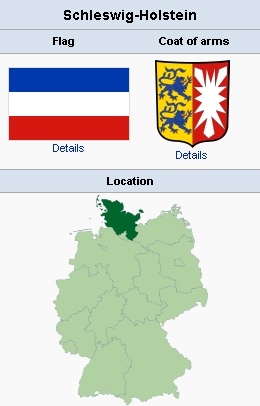Schleswig-Holstein (Germany)

Schleswig-Holstein, now one of 16 states in Germany, was Danish during the Reformation and later. The Anabaptists found refuge there early in the 16th century, particularly in the rural areas. Evidently as early as 1528 action was taken against Anabaptists. Anabaptists were found early near Lübeck, where among others the Roosen family was located. In eastern Holstein the king issued an edict against the Anabaptists and Sacramentists in 1553. In southern Holstein, Anabaptists were found in Wandsbeck, Pinneberg, and Oldesloe.
In the southwest the Anabaptists were important in the economic life, transforming certain aspects of agriculture; e.g., farmers changed from cattle-raising to the production of milk and cheese. Some of the places mentioned are Wilster, Brockdorf, and Wewelsfleth. As in East Friesland the first Anabaptists in Schleswig-Holstein were primarily refugees from the Low Countries.
In Steinburg the Mennonites had to report to the government on 6 August 1635, with the result that an edict was issued against them and they were asked to join the Lutheran Church. Another edict followed in 1642. From the early days the Mennonites enjoyed full privileges in Wüstenfelde near Oldesloe, Glückstadt, and later in Altona. Gradually the Mennonites disappeared from the rural areas, surviving only in such cities as Friedrichstadt, Altona, and Hamburg. A law of 14 July 1863 made it possible for Mennonites to settle and move freely throughout Schleswig-Holstein.
The Wüstenfelde congregation near Oldesloe, where Menno Simons and his followers found refuge, is unique. Menno Simons spent the last years of his life at Wüstenfelde, where he published his books, died, and was buried. The Wüstenfelde settlement was destroyed during the Thirty Years' War and most of the Mennonites moved to Altona. Here the Mennonites became city builders as in the case of Krefeld. Outstanding was the van der Smissen family.
Only a few of the early Mennonite churches have survived, among them Friedrichstadt and Hamburg-Altona: the latter has grown considerably since World War II because of the influx of Mennonite refugees from the East. Additional Mennonite congregations and groups have been established in Kiel, Lübeck, and the group known by the name of Schleswig-Holstein Mennonite Church, with one meetinghouse at Wedel, built in 1958.
Mennonite settlements were established in 1952 at Pinneberg-Rellingen. The Mennonite Central Committee helped the refugees of Schleswig-Holstein first with Kiel as a center (1946-47) and later from Hamburg (1948-56). In 1950 the Mennonite refugee population of Schleswig-Holstein was 4,300, and in 1958 the total number affiliated with Mennonite congregations was about 2,000.
Bibliography
Dollinger, Robert. Geschichte der Mennoniten in Schleswig-Holstein, Hamburg und Lübeck. Neumünster, 1930.
Hege, Christian and Christian Neff. Mennonitisches Lexikon, 4 vols. Frankfurt & Weierhof: Hege; Karlsruhe: Schneider, 1913-1967: v. IV, 73.
Krahn, Cornelius. Menno Simons. Karlsruhe, 1935.
Münte, Heinz. Das Altonaer Handlungshaus van der Smissen. Altona, 1932.
| Author(s) | Cornelius Krahn |
|---|---|
| Date Published | 1959 |
Cite This Article
MLA style
Krahn, Cornelius. "Schleswig-Holstein (Germany)." Global Anabaptist Mennonite Encyclopedia Online. 1959. Web. 3 Dec 2024. https://gameo.org/index.php?title=Schleswig-Holstein_(Germany)&oldid=144600.
APA style
Krahn, Cornelius. (1959). Schleswig-Holstein (Germany). Global Anabaptist Mennonite Encyclopedia Online. Retrieved 3 December 2024, from https://gameo.org/index.php?title=Schleswig-Holstein_(Germany)&oldid=144600.
Adapted by permission of Herald Press, Harrisonburg, Virginia, from Mennonite Encyclopedia, Vol. 4, pp. 461-462. All rights reserved.
©1996-2024 by the Global Anabaptist Mennonite Encyclopedia Online. All rights reserved.
